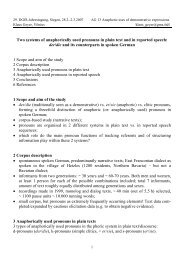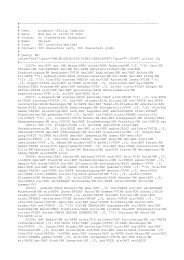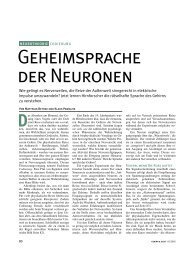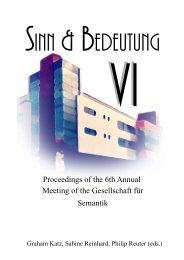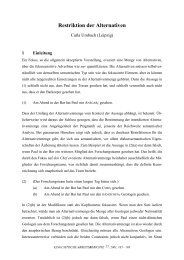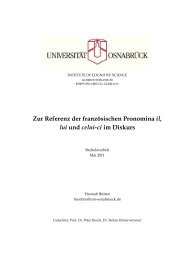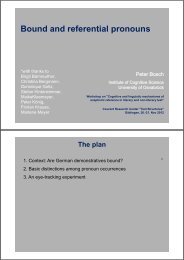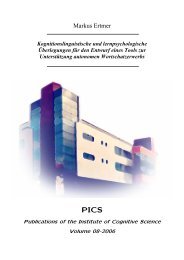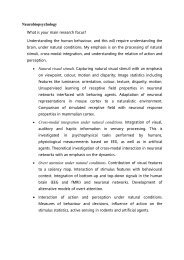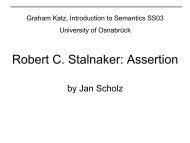Demonstrative Pronouns and Personal Pronouns. German der vs. er.
Demonstrative Pronouns and Personal Pronouns. German der vs. er.
Demonstrative Pronouns and Personal Pronouns. German der vs. er.
You also want an ePaper? Increase the reach of your titles
YUMPU automatically turns print PDFs into web optimized ePapers that Google loves.
we have not been able to acquire. So we have to<br />
leave this point to speculation 3 .<br />
So, why would one want a computational<br />
identification of demonstratives, <strong>and</strong> why would<br />
one want a bett<strong>er</strong> un<strong>d<strong>er</strong></strong>st<strong>and</strong>ing of their ref<strong>er</strong>ence?<br />
On the one h<strong>and</strong>, th<strong>er</strong>e is of course the motivation<br />
from applications, similar as for all oth<strong>er</strong><br />
work on ref<strong>er</strong>ence resolution: A treatment of<br />
demonstratives is clearly needed, e.g., for machine<br />
translation. Nearly no <strong>G<strong>er</strong>man</strong> demonstrative<br />
can be adequately translated into English, or<br />
most oth<strong>er</strong> languages, without ref<strong>er</strong>ence resolution.<br />
On the oth<strong>er</strong> h<strong>and</strong>, independent of applications,<br />
we believe that an improved un<strong>d<strong>er</strong></strong>st<strong>and</strong>ing<br />
of demonstratives may contribute both to a bett<strong>er</strong><br />
un<strong>d<strong>er</strong></strong>st<strong>and</strong>ing of processes of pronominal ref<strong>er</strong>ence<br />
<strong>and</strong> to theoretical accounts of information<br />
structure <strong>and</strong> the dynamics of discourse.<br />
The int<strong>er</strong>esting point about <strong>G<strong>er</strong>man</strong> demonstratives<br />
in this connection is that they allow for<br />
a fairly direct comparison of pronominal anaphoric<br />
<strong>and</strong> demonstrative ref<strong>er</strong>ence in a way this<br />
comparison is not possible for oth<strong>er</strong> languages.<br />
In English we could look at diff<strong>er</strong>ences between<br />
it, this, <strong>and</strong> that. But h<strong>er</strong>e the range of potential<br />
ref<strong>er</strong>ents brings in a numb<strong>er</strong> of additional complications<br />
(cf. Passonneau 1989, Webb<strong>er</strong> 1991,<br />
Eck<strong>er</strong>t & Strube 2000) that are avoided when we<br />
compare p<strong>er</strong>sonal <strong>and</strong> demonstrative pronouns in<br />
<strong>G<strong>er</strong>man</strong>.<br />
This pap<strong>er</strong> takes a few modest steps towards<br />
an account of the distribution <strong>and</strong> ref<strong>er</strong>ence of<br />
demonstratives, but what we have to off<strong>er</strong> is still<br />
work in progress. We have not yet looked at all<br />
forms of the demonstrative. What we have<br />
worked out so far is an hypothesis about the distinction<br />
between diff<strong>er</strong>ent uses of the demonstrative<br />
<strong>and</strong> p<strong>er</strong>sonal pronouns, <strong>and</strong> we have put this<br />
hypothesis to the test with a small 350,000 word<br />
corpus of written <strong>G<strong>er</strong>man</strong>.<br />
3 The V<strong>er</strong>bmobil corpus of spoken <strong>G<strong>er</strong>man</strong> (http:// v<strong>er</strong>bmobil.dfki.de/)<br />
has a ratio of p<strong>er</strong>sonal pronouns to demonstratives of<br />
1:4, while the Negra corpus of written <strong>G<strong>er</strong>man</strong> yields about 8:1.<br />
Howev<strong>er</strong>, this comparison remains inconclusive: the V<strong>er</strong>bmobil<br />
corpus consists of dialogues negotiating the time <strong>and</strong> place of appointments,<br />
while the Negra corpus is a regular daily newspap<strong>er</strong><br />
corpus with obviously vastly diff<strong>er</strong>ent discourse structure.<br />
2 <strong>Demonstrative</strong> <strong>and</strong> p<strong>er</strong>sonal pronouns<br />
At a first glance th<strong>er</strong>e is consi<strong>d<strong>er</strong></strong>able ov<strong>er</strong>lap in<br />
the distribution of demonstrative <strong>and</strong> p<strong>er</strong>sonal<br />
pronouns. In many contexts, as already in example<br />
(2), eith<strong>er</strong> form seems acceptable <strong>and</strong> semantic,<br />
pragmatic, or even stylistic diff<strong>er</strong>ences are<br />
hard to pinpoint. This is also true in the following<br />
cases:<br />
(3) Am Dienstag, 16. Juni, können dann Falkenstein<strong>er</strong><br />
ihren Son<strong>d<strong>er</strong></strong>müll von 9 bis 10 Uhr zu<br />
dem Wagen bringen. {Er/D<strong>er</strong>} parkt auf<br />
dem Parkplatz beim Bürg<strong>er</strong>haus.<br />
[On Tuesday, 16 June, the Falkenstein<strong>er</strong>s can<br />
take their hazardous waste to the van between<br />
9 <strong>and</strong> 10 a.m. It is parked in the parking<br />
lot at the Civic Centre.]<br />
(4) Zunächst waren die Mietfor<strong>d<strong>er</strong></strong>ungen des<br />
Investors (38 Mark pro Quadratmet<strong>er</strong>) zu<br />
hoch. {Er/D<strong>er</strong>} reduzi<strong>er</strong>te sie dann auf unt<strong>er</strong><br />
30 Mark.<br />
[At first the rent dem<strong>and</strong>s of the investor (38<br />
marks p<strong>er</strong> square met<strong>er</strong>) w<strong>er</strong>e too high. Then<br />
he reduced them to un<strong>d<strong>er</strong></strong> 30 Marks.]<br />
The impression that th<strong>er</strong>e is an area of ov<strong>er</strong>lap<br />
wh<strong>er</strong>e the function of the demonstrative pronoun<br />
is indistinguishable from the anaphoric p<strong>er</strong>sonal<br />
pronoun <strong>and</strong> wh<strong>er</strong>e the two forms could be substituted<br />
for each oth<strong>er</strong> without a clear grammatical<br />
or semantic diff<strong>er</strong>ence was confirmed in two<br />
psycholinguistic exp<strong>er</strong>iments carried out by our<br />
project group (see Cummins et al. (in preparation)).<br />
Self-paced reading as well as native<br />
speak<strong>er</strong>s' acceptability pref<strong>er</strong>ences yielded no<br />
significant diff<strong>er</strong>ence.<br />
This functional ov<strong>er</strong>lap of p<strong>er</strong>sonal <strong>and</strong> demonstrative<br />
pronouns may well be an artefact of<br />
un<strong>d<strong>er</strong></strong>specified data though. If, as we shall argue,<br />
the diff<strong>er</strong>ence between the two types of pronouns<br />
is a matt<strong>er</strong> of information structure, then the distinction<br />
may not show up when not enough information<br />
structure is visible – most clearly<br />
when we consi<strong>d<strong>er</strong></strong> odd sentences in isolation, but<br />
often also in sentence pairs.<br />
Still, th<strong>er</strong>e are occurrences of the two pronoun<br />
types for which the diff<strong>er</strong>ence is quite clear<br />
as already in (1), repeated h<strong>er</strong>e:



